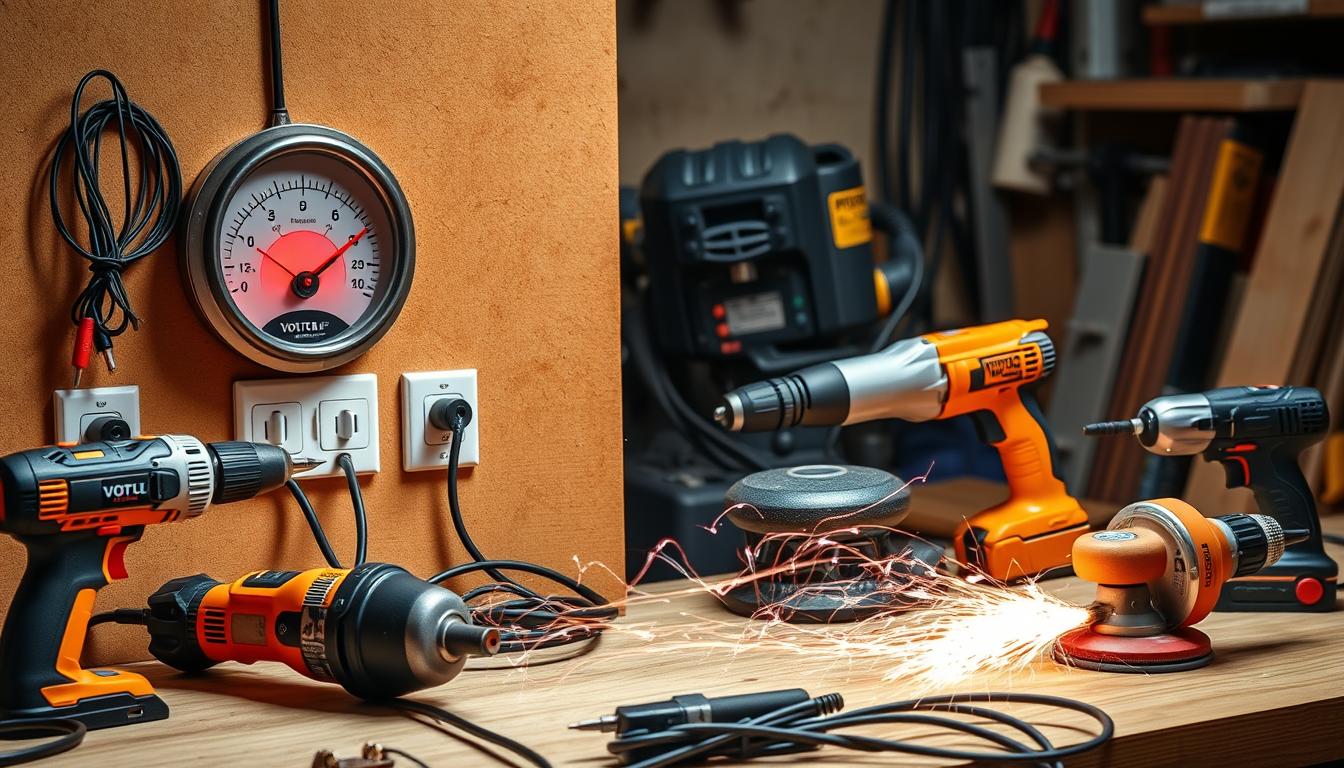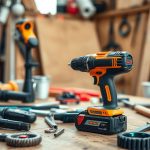Knowing about tool voltage is key for safe and efficient projects. The right tool voltage is crucial for each task. A good tool voltage guide helps you choose wisely.
Understanding power needs is vital for success and safety. Knowing about tool voltage helps you pick the best tool. It’s important for both DIY fans and pros.
Key Takeaways
- Understanding tool voltage guide is essential for project safety and efficiency
- Power requirements vary depending on the task and tool
- A comprehensive tool voltage guide can help with tool selection
- Knowing power requirements can prevent accidents and ensure desired results
- Understanding tool voltage is crucial for both DIY and professional projects
- Tool voltage affects the overall performance and effectiveness of power tools
The Basics of Tool Voltage
Understanding tool voltage is key for any project with power tools. It’s important to compare voltages when picking the right tool. Also, knowing the tool’s power rating helps figure out how well it will work.
Voltage shows the difference in electrical potential between two points in a circuit. It’s crucial for a tool’s power and efficiency. A higher voltage usually means a more powerful tool.
What is Voltage?
Voltage is measured in volts (V). It’s a key part of a power tool’s performance. When looking at tool power ratings, check the voltage to make sure it fits the project.
How Voltage Affects Power Tools
The voltage of a power tool impacts its speed, torque, and performance. A tool with higher voltage will have more speed and torque. This makes it better for tough projects.
Common Voltage Ratings Explained
Power tools often have voltages like 12V, 18V, and 20V. Each has its own benefits and drawbacks. For instance, 12V tools are smaller and lighter. But 18V and 20V tools are more powerful for heavy tasks.
When choosing a power tool, think about voltage and power ratings. This helps ensure the tool meets the project’s needs. Knowing about tool voltage helps you pick the best tool for the job.
Different Types of Power Tool Voltage Systems
Knowing the electrical basics of power tool voltage systems is key. There are many types, like cordless and corded systems. Each has its own benefits and uses.
Cordless tools are easy to move around, while corded ones give steady power. It’s important to pick the right tool for your job. Electrical basics like voltage, current, and resistance affect how well tools work.
- 12V systems, suitable for light-duty applications
- 18V systems, ideal for medium-duty projects
- 20V systems, commonly used for heavy-duty construction work
Understanding power tool voltage systems and their electrical basics helps you choose the best tools. This ensures your projects run smoothly, safely, and efficiently.
Cordless vs. Corded Tool Voltage: Making the Right Choice
Choosing between cordless and corded power tools depends on voltage. The right voltage affects tool performance and efficiency. We’ll look at cordless and corded tool benefits to help you decide.
Advantages of Cordless Systems
Cordless tools offer flexibility and convenience. They let you move freely without being tied to a power source. Thanks to better batteries, cordless tools now match corded tools in power and performance.
Benefits of Corded Power Tools
Corded tools provide steady power, perfect for heavy tasks and long use. They’re often cheaper and need less upkeep than cordless tools.
Voltage Considerations for Each Type
When picking between cordless and corded tools, think about your project’s voltage needs. Cordless tools usually run at 12 to 24 volts. Corded tools can go up to 240 volts. Choosing the right voltage ensures your tools work well, efficiently, and safely.
How Tool Voltage Impacts Performance and Efficiency
It’s key to know how tool voltage affects performance and safety. Studies show that higher voltages mean more powerful tools. But, they also raise the risk of accidents if not used right. Tool performance improves with higher voltages, leading to faster and more efficient work.
Voltage is a big deal for tool performance. Higher voltages mean more power and speed, perfect for tough jobs. Yet, higher voltages can also mean more heat and a risk of electrical shock. So, picking the right voltage is vital for both performance and safety.
- Voltage rating: The tool’s voltage rating affects its power, with higher voltages offering more.
- Tool type: Cordless or corded tools have different voltage needs and performance.
- Application: The task at hand also matters, with tougher jobs needing higher voltages.
Understanding tool voltage and tool performance helps users choose the best tools. This ensures they get the job done well, efficiently, and safely.
Battery Voltage in Cordless Tools
Battery voltage is key in cordless tools for their performance and efficiency. As a tool voltage guide, knowing how battery voltage and amp hours relate is crucial. This knowledge helps choose the right tools for your projects.
The battery platform is another important factor. Most cordless tools run on specific voltages like 12V, 18V, or 20V. Knowing these differences helps pick the best tool for your needs.
Understanding Battery Platforms
Each battery platform has unique features like voltage, amp hours, and expected runtime. For instance, a 12V battery is good for light tasks. But, an 18V or 20V is better for heavy tasks.
Voltage vs. Amp Hours
The link between voltage and amp hours affects a tool’s runtime. A high-voltage battery with low amp hours might not last as long as a low-voltage one with high amp hours. Generally, higher voltage means more power, while more amp hours mean longer use.
Runtime Expectations
Knowing a tool’s runtime is vital for uninterrupted work. By looking at voltage, amp hours, and platform, you can guess a tool’s runtime. With the right tool voltage guide, you can pick the best cordless tools. This ensures you have the power and runtime needed to finish your tasks.
Safety Considerations When Working with Different Voltages
When using power tools, it’s key to think about safety implications of different voltages. Knowing what power tools need is vital to avoid accidents and keep the work area safe. The Occupational Safety and Health Administration (OSHA) gives rules for using electrical power tools. They stress the need for proper handling, storage, and use.
To stay safe, follow these important steps:
- Use tools with the correct voltage rating for the task
- Avoid overloading circuits
- Keep work areas clean and dry
- Regularly inspect tools for damage
By understanding power needs and following safety rules, people can lower the risk of electrical shock and other accidents. The National Institute for Occupational Safety and Health (NIOSH) says, “electrical safety is a critical aspect of workplace safety.”
Always put safety first when working with power tools. Being aware of dangers and taking the right steps helps keep the work area safe and productive.
Matching Tool Voltage to Your Project Requirements
Choosing the right power tool for your project is all about voltage. Each project needs a specific voltage level. Using the wrong one can make your tool less effective or even unsafe. We’ll show you how to pick the right tool voltage for your project.
For light tasks like drilling small holes or driving screws, a tool with 10-20 volts is enough. But, for cutting through thicker materials or driving bigger screws, you’ll need a tool with 20-40 volts.
Project Voltage Requirements
- Light-Duty Projects: 10-20 volts
- Medium-Duty Applications: 20-40 volts
- Heavy-Duty Construction Work: 40-60 volts or higher
For really tough jobs like cutting concrete or driving huge nails, you need a tool with 40-60 volts or more. Picking the right tool based on voltage ensures you get the job done well and safely.
Remember, comparing voltages is key to choosing the right tool for your project. Knowing the voltage needs for different tasks helps you make smart choices. This way, you can get professional results.
| Project Type | Voltage Requirement |
|---|---|
| Light-Duty | 10-20 volts |
| Medium-Duty | 20-40 volts |
| Heavy-Duty | 40-60 volts or higher |
Common Misconceptions About Power Tool Voltage
There are many myths about power tool voltage that can confuse us. Knowing electrical basics helps clear up these misunderstandings. One myth is that higher voltage always means more power. But, the relationship between voltage and tool performance is more complex.
Another myth is that cordless tools are less powerful than corded ones. While cordless tools used to have lower voltage, new technology has changed this. Now, many cordless tools perform as well as corded ones, making them great for various tasks. Electrical basics show that voltage, current, and resistance are connected. Tool makers have improved these factors for cordless tools.
Some common misconceptions about power tool voltage include:
- Voltage is the only factor that determines tool performance
- Cordless tools are always less powerful than corded tools
- Higher voltage always means more power
Understanding electrical basics helps us choose the right tools for our projects. Whether you’re a pro contractor or a DIY fan, knowing about power tool voltage is key. It makes your work more efficient and effective.
| Tool Type | Voltage Rating | Application |
|---|---|---|
| Cordless Drill | 18V | Light-duty projects |
| Corded Circular Saw | 120V | Heavy-duty construction work |
| Cordless Impact Driver | 20V | Medium-duty applications |
Voltage Requirements for Professional vs. DIY Tools
Choosing the right power tools for your project means knowing about voltage. Professional tools are built for heavy use. They have more voltage and power to tackle tough tasks easily. DIY tools, on the other hand, are for home use and don’t need as much power.
Professional tools have higher tool power ratings. This means they can do more work faster. For example, a pro drill might be 18V or 20V. A DIY drill is usually 12V or 14V. Knowing these tool power ratings helps you pick the best tool for your project.
- Professional grade tools: made for heavy use and high performance, with higher voltage and power ratings
- DIY tools: for home use and lighter projects, with lower voltage and power ratings
The choice between professional and DIY tools depends on your project needs. Understanding voltage and tool power ratings helps you make the right choice for your job.
Future Trends in Power Tool Voltage Technology
Technology keeps getting better, and power tool voltage tech is no exception. Makers are focusing on voltage selection to create tools that work better, last longer, and are easier to use.
There’s always new research on power tool voltage tech. This includes better batteries and quicker charging times.
Emerging Battery Technologies
New battery tech is coming to make power tools even better. These changes will help users pick the right voltage selection for their needs.
Innovations in Voltage Management
New ideas in voltage management are also on the horizon. They aim to make tools more efficient and safe. These changes will change the game for power tool voltage tech, helping users work smarter and greener.
Knowing about the latest in power tool voltage tech helps users make better choices. This leads to better performance, ease of use, and being kinder to the planet in their work.
International Voltage Standards and Compatibility
When using power tools around the world, knowing the tool voltage guide is key. Each country has its own standard voltage. This affects how well power tools work and if they’re safe to use. For example, the U.S. runs on 120V, but many European countries use 230V.
To use power tools safely overseas, you must know the local voltage rules. A tool voltage guide helps by showing the needed voltage for each place. Also, using a voltage converter or a tool that works on any voltage can solve problems.
Important things to think about for international voltage standards and compatibility include:
- Looking up the local voltage standards for your destination
- Using a voltage converter or a tool that works on any voltage
- Checking a tool voltage guide for details on tool compatibility
Knowing about international voltage standards and taking the right steps ensures power tools work well and safely abroad. This makes a tool voltage guide a must-have for any project outside your country.
Conclusion: Making Informed Decisions About Tool Voltage
When starting your next power tool project, knowing about power needs and voltage is crucial. The voltage of your tools affects their efficiency, safety, and project success.
With the knowledge from this article, you can pick the right tools for any job. This ensures your projects are done well and with ease. Whether you’re a DIY expert or a pro, knowing about power tool voltage helps you make better choices.
Understanding voltage is powerful. It guides you in your next project. With the right tools and voltage, your projects can reach new heights.


